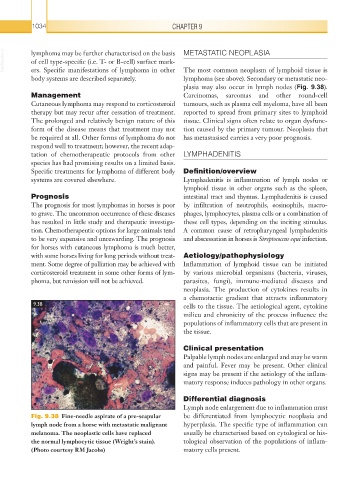Page 1059 - Equine Clinical Medicine, Surgery and Reproduction, 2nd Edition
P. 1059
1034 CHAPTER 9
VetBooks.ir lymphoma may be further characterised on the basis METASTATIC NEOPLASIA
of cell type-specific (i.e. T- or B-cell) surface mark-
ers. Specific manifestations of lymphoma in other
lymphoma (see above). Secondary or metastatic neo-
body systems are described separately. The most common neoplasm of lymphoid tissue is
plasia may also occur in lymph nodes (Fig. 9.38).
Management Carcinomas, sarcomas and other round-cell
Cutaneous lymphoma may respond to corticosteroid tumours, such as plasma cell myeloma, have all been
therapy but may recur after cessation of treatment. reported to spread from primary sites to lymphoid
The prolonged and relatively benign nature of this tissue. Clinical signs often relate to organ dysfunc-
form of the disease means that treatment may not tion caused by the primary tumour. Neoplasia that
be required at all. Other forms of lymphoma do not has metastasised carries a very poor prognosis.
respond well to treatment; however, the recent adap-
tation of chemotherapeutic protocols from other LYMPHADENITIS
species has had promising results on a limited basis.
Specific treatments for lymphoma of different body Definition/overview
systems are covered elsewhere. Lymphadenitis is inflammation of lymph nodes or
lymphoid tissue in other organs such as the spleen,
Prognosis intestinal tract and thymus. Lymphadenitis is caused
The prognosis for most lymphomas in horses is poor by infiltration of neutrophils, eosinophils, macro-
to grave. The uncommon occurrence of these diseases phages, lymphocytes, plasma cells or a combination of
has resulted in little study and therapeutic investiga- these cell types, depending on the inciting stimulus.
tion. Chemotherapeutic options for large animals tend A common cause of retropharyngeal lymphadenitis
to be very expensive and unrewarding. The prognosis and abscessation in horses is Streptococcus equi infection.
for horses with cutaneous lymphoma is much better,
with some horses living for long periods without treat- Aetiology/pathophysiology
ment. Some degree of palliation may be achieved with Inflammation of lymphoid tissue can be initiated
corticosteroid treatment in some other forms of lym- by various microbial organisms (bacteria, viruses,
phoma, but remission will not be achieved. parasites, fungi), immune-mediated diseases and
neoplasia. The production of cytokines results in
a chemotactic gradient that attracts inflammatory
9.38 cells to the tissue. The aetiological agent, cytokine
milieu and chronicity of the process influence the
populations of inflammatory cells that are present in
the tissue.
Clinical presentation
Palpable lymph nodes are enlarged and may be warm
and painful. Fever may be present. Other clinical
signs may be present if the aetiology of the inflam-
matory response induces pathology in other organs.
Differential diagnosis
Lymph node enlargement due to inflammation must
Fig. 9.38 Fine-needle aspirate of a pre-scapular be differentiated from lymphocytic neoplasia and
lymph node from a horse with metastatic malignant hyperplasia. The specific type of inflammation can
melanoma. The neoplastic cells have replaced usually be characterised based on cytological or his-
the normal lymphocytic tissue (Wright’s stain). tological observation of the populations of inflam-
(Photo courtesy RM Jacobs) matory cells present.

